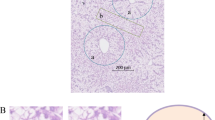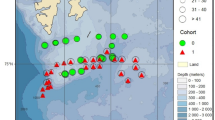Abstract
Knowledge of the structure and energy reserves, in the liver of commercially important fish species, is important in understanding metabolic processes and in assessing the impact of potential environmental physical and chemical stressors in both wild and cultured stocks. The present study investigated the microscopic morphology and histochemistry (total and neutral lipids, glycogen) of liver tissue of wild (3+) and cultured (1+) sexually immature female and male yellowtail flounder (Limanda ferruginea Storer), sampled in late April 2001. Hepatosomatic indices [HSI: (liver weight/body weight−liver weight)×100] of cultured fish were significantly higher than those of wild fish. Females in the cultured group had significantly lower HSIs than males. The liver of both wild and cultured L. ferruginea was interspersed with pancreatic tissue. The main components of the liver tissue were irregular cords of hepatocytes arranged in tubules which surrounded vascular sinusoids. The hepatocytes contained an abundance of lipid, much of which appeared to be neutral lipids, in both sexes of the cultured fish. Total and neutral lipid droplets were larger, and the area occupied by these droplets was significantly greater in both cultured females and males compared to the wild fish, suggesting lipidosis in the cultured fish. In the cultured fish these differences were sex-dependent, the females having significantly more total and neutral lipids in hepatocytes than the males. This suggests a potentially greater storage capacity in females and/or a higher lipid metabolism in males. There were no statistically significant differences in glycogen content between the cultured and wild fish, or between the sexes in both sampling groups.




Similar content being viewed by others
References
Ando S, Mori Y, Nakamura K, Sugawara K (1993) Characteristics of lipid accumulation types in five species of fish. Nippon Sochi Gakkai-Shi 59:1559–1564
Blaxter JHS (1975) Reared and wild fish-how do they compare? In: Persoone G, Jaspers E (eds) Proc 10th Eur Symp Mar Biol. Universa, Wettern, Belgium, pp 11–26
Brown J, Helm M, Moir J (1995) New candidate species for aquaculture. In: Boghen AD (ed) Cold water aquaculture in Atlantic Canada, 2nd edn. Tribune Press, Sackville, New Brunswick, pp 341–362
Bucher F, Hofer R, Salvenmoser W (1992) Effects of treated paper mill effluents on hepatic morphology in male bullhead (Cottus gobio L.). Arch Environ Contam Toxicol 23:410–419
Carr RS, Hillman RE, Neff JM (1991) Field assessment of biomarkers for winter flounder. Mar Pollut Bull 22:61–67
Carson FL (1990) Histotechnology—a self-instructional text. ASCP Press, Chicago
Chayen J, Bitensky L (1991) Practical histochemistry, 2nd edn. Wiley, Toronto
Chilton DE, Beamish RJ (1982) Age determination methods for fishes studied by the Groundfish Program at the Pacific Biological Station. Can Spec Publ Fish Aquat Sci 60:1–54
Clearwater SJ (1996) The reproductive physiology of yellowtail flounder (Pleuronectes ferrugineus), with an emphasis on sperm physiology. PhD thesis, Memorial University of Newfoundland, St. John's
Collier TK, Anulacion BF, Bill BD (1998) Hepatic CYP1A in winter flounder (Pleuronectes americanus) along the northeast coast: results from the National Benthic Surveillance Project. Mar Pollut Bull 37:86–91
Dwyer K, Brown JA, Parrish CC, Lall S (2002) Feeding frequency affects growth, food consumption, feeding pattern and behaviour in juvenile yellowtail flounder. Aquaculture 213:279–292
Hampton JA, McCuskey PA, McCuskey RS, Hinton DE (1985) Functional units in rainbow trout (Salmo gairdneri, Richardson) liver. I. Histochemical properties and arrangements of hepatocytes. Anat Rec 213:166–175
Hampton JA, Lantz RC, Goldblatt PJ, Lauren DJE, Hinton DE (1988) Functional units in rainbow trout (Salmo gairdneri, Richardson) liver. II. The biliary system histochemical properties and arrangements of hepatocytes. Anat Rec 221:619–634
Harmin SA, Crim LW, Wiegand MD (1995) Plasma sex steroid profiles and the seasonal reproductive cycle in male and female winter flounder, Pleuronectes americanus. Mar Biol 121:601–610
Herbinger CM, Friars GW (1992) Effects of winter temperature and feeding regime on the rate of early maturation in Atlantic salmon (Salmo salar) male parr. Aquaculture 101:147–162
Hinton DE (1993) Toxicologic histopathology of fishes: a systemic approach and overview. In: Couch JA, Fournie JW (eds) Advances in fisheries science—pathology of marine and estuarine organisms. CRC Press, London
Hinton DE, Lauren DJ (1989) In vivo microscopy of liver microvasculature in rainbow trout (Oncorhynchus mykiss). Mar Environ Res 28:407–410
Hinton DE, Pool CR (1976) Ultrastructure of the liver in channel catfish Ictalurus punctatus (Rafinesque). J Fish Biol 8:209–219
Howell WH (1983) Seasonal changes in the ovaries of adult yellowtail flounder, Limanda ferruginea. Fish Bull (Wash DC) 81:341–355
Husøy A-M, Myers MS, Goksøyr A (1996) Cellular localization of cytochrome P450 (CYP1A) induction and histology in Atlantic cod (Gadus morhua L.) and European flounder (Platichthys flesis) after environmental exposure to contaminants by caging in Sørfjorden, Norway. Aquat Toxicol 36:53–74
Kiernan JA (1990) Histological and histochemical methods: theory and practice, 2nd edn. Pergamon, Toronto
Köhler A (1989) Cellular effects of environmental contamination in fish from the river Elbe and the North Sea. Mar Environ Res 28:417–424
Köhler A (1990) Identification of contaminant-induced cellular and subcellular lesions in the liver of flounder (Platichthys flesus L.) caught at differently polluted estuaries. Aquat Toxicol 16:271–294
Köhler A, Pluta HJ (1995) Lysosomal injury and MFO activity in the liver of flounder (Platichthys flesus L.). In: Relation to histopathology of hepatic degeneration and carcinogenesis. Mar Environ Res 39:225–260
Köhler A, Deisemann H, Lauritzen B (1992) Histological and cytochemical indices of toxic injury in the liver of dab Limanda limanda. Mar Ecol Prog Ser 91:141–153
Köhler A, Bahns S, Van Noorden CJF (1998) Determination of kinetic properties of G6PDH and PGDH and the expression of PCNA during liver carcinogenesis in coastal flounder. Mar Environ Res 46:179–183
Krauss WJ, Cutts JH (1994) Essentials of histology text/atlas/review. Little, Brown and Company, Toronto
Langton RW (1979) Food habits of yellowtail flounder, Limanda ferruginea (Storer), from off the northeastern United States. Fish Bull (Wash DC) 81:15–22
Libey GS, Cole CF (1979) Food habits of yellowtail flounder, Limanda ferruginea (Storer). J Fish Biol 15:371–374
Manning AJ, Crim LW (1998) Maternal and inter-annual comparison of the ovulatory periodicity, egg production and egg quality of the batch-spawning yellowtail flounder. J Fish Biol 53:954–972
March PE, Reisman HM (1995) Seasonal changes in hepatocyte ultrastructure correlated with the cyclic synthesis of secretory proteins in the winter flounder (Pleuronectes americanus). Cell Tissue Res 281:153–161
Methven DA, Schneider DC (1998) Gear-independent patterns of variation in catch of juvenile cod (Gadus morhua) in coastal habitats. Can J Fish Aquat Sci 55:1430–1442
Morgan MJ, Walsh SJ (1997) Observations on maturation, recruitment and spawning stock biomass in yellowtail flounder on the Grand Bank. NAFO (Northwest Atl Fish Organ) SCR Doc 97/71:1–7
Morrison CM (1987) Histology of the Atlantic cod, Gadus morhua: an atlas, part 1. Digestive tract and associated organs. Can Spec Publ Fish Aquat Sci 98
Murchelano RA, Wolke RE (1991) Neoplasms and nonneoplastic liver lesions in winter flounder, Pseudopleuronectes americanus, from Boston Harbor, Massachusetts. Environ Health Perspect 90:17–26
Myers MS, Johnson LL, Hom T, Collier TK, Stein JE, Varanasi U (1998) Toxicopathic hepatic lesions in subadult English sole (Pleuronectes vetulus) from Puget Sound, Washington, USA: relationships with other biomarkers of contaminant exposure. Mar Environ Res 45:47–67
Parrish CC, Yang Z, Lau A, Thompson RJ (1996) Lipid composition of Yoldia hyperborea (Protobranchia), Nephthys ciliata (Nephthyidae) and Artacama proboscidea (Terebellidae) living at sub-zero temperatures. Comp Biochem Physiol B 114:59–67
Pitt TK (1970) Distribution, abundance, and spawning of yellowtail flounder, Limanda ferruginea, in the Newfoundland area of the northwest Atlantic. J Fish Res Board Can 27:2261–2271
Pitt TK (1974) Age composition and growth of yellowtail flounder (Limanda ferruginea) from the Grand Bank. J Fish Res Board Can 31:1800–1802
Pitt TK (1983) Underwater world—yellowtail flounder. Department of Fisheries and Oceans, Ottawa
Rabe J, Brown JA (2000) A pulse feeding strategy for rearing larval fish: an experiment with yellowtail flounder. Aquaculture 191:289–302
Royce WF, Buller RJ, Premetz ED (1959) Decline of the yellowtail flounder Limanda ferruginea off New England. Fish Bull (Wash DC) 59:169–267
Scott KD, Fåhraeus-Van Ree GE, Parrish CC (2002) Sex differences in hepatic lipids of toxaphene-exposed juvenile yellowtail flounder (Pleuronectes ferrugineus Storer). Ecotoxicol Environ Saf 46:289–297
Sheehan DC, Hrapchak BB (1980) Theory and practice of histotechnology, 2nd edn. Mosby, Toronto
Snowberger Gray E, Woodin BR, Stegeman JJ (1991) Sex differences in hepatic monooxygenases in winter flounder (Pseudopleuronectes americanus) and scup (Stenotomus chrysops) and regulation of P450 forms by estradiol. J Exp Zool 259:330–342
Stehr CM, Rhodes LD, Myers MS (1988) The ultrastructure and histology of hepatocellular carcinomas of English sole (Parophrys vetulus) from Puget Sound, Washington. Toxicol Pathol 16:418–431
Timashova LV (1982) Seasonal changes in the structure of the liver of the plaice, Pleuronectes platessa. J Ichthyol 21:145–151
Vethaak AD, Wester PW (1996) Diseases of flounder Platichthys flesus in Dutch coastal and estuarine waters, with particular reference to environmental stress factors. II. Liver histopathology. Dis Aquat Org 26:99–116
Welsch UN, Storch VN (1973) Enzyme histochemical and ultrastructural observations on the liver of teleost fishes. Arch Histol Jpn 36:21–37
Whalen KS (1999) Lipid utilization and feeding of juvenile yellowtail flounder (Pleuronectes ferrugineus). Masters thesis (Aquaculture), Ocean Sciences Centre, Memorial University of Newfoundland, St. John's
Acknowledgements
The authors thank L. Barrett, C. Mercer, A. Squires, and H. Baikie for their technical assistance, K. Dwyer for the age determinations of the otoliths, and R. Ficken for preparing the photographs.
Author information
Authors and Affiliations
Corresponding author
Additional information
Communicated by J.P. Grassle, New Brunswick
Rights and permissions
About this article
Cite this article
Fåhraeus-Van Ree, G., Spurrell, D. Structure of and energy reserves in the liver of wild and cultured yellowtail flounder, Limanda ferruginea . Marine Biology 143, 257–265 (2003). https://doi.org/10.1007/s00227-003-1083-y
Received:
Accepted:
Published:
Issue Date:
DOI: https://doi.org/10.1007/s00227-003-1083-y




